Contents
- TensorFlow - 구글 머신러닝 플랫폼
- 1. 텐서 기초 살펴보기
- 2. 간단한 신경망 만들기
- 3. 손실 함수 살펴보기
- 4. 옵티마이저 사용하기
- 5. AND 로직 연산 학습하기
- 6. 뉴런층의 속성 확인하기
- 7. 뉴런층의 출력 확인하기
- 8. MNIST 손글씨 이미지 분류하기
- 9. Fashion MNIST 이미지 분류하기
- 10. 합성곱 신경망 사용하기
- 11. 말과 사람 이미지 분류하기
- 12. 고양이와 개 이미지 분류하기
- 13. 이미지 어그멘테이션의 효과
- 14. 전이 학습 활용하기
- 15. 다중 클래스 분류 문제
- 16. 시냅스 가중치 얻기
- 17. 시냅스 가중치 적용하기
- 18. 모델 시각화하기
- 19. 훈련 과정 시각화하기
- 20. 모델 저장하고 복원하기
- 21. 시계열 데이터 예측하기
- 22. 자연어 처리하기 1
- 23. 자연어 처리하기 2
- 24. 자연어 처리하기 3
- 25. Reference
- tf.cast
- tf.constant
- tf.keras.activations.exponential
- tf.keras.activations.linear
- tf.keras.activations.relu
- tf.keras.activations.sigmoid
- tf.keras.activations.softmax
- tf.keras.activations.tanh
- tf.keras.datasets
- tf.keras.layers.Conv2D
- tf.keras.layers.Dense
- tf.keras.layers.Flatten
- tf.keras.layers.GlobalAveragePooling2D
- tf.keras.layers.InputLayer
- tf.keras.layers.ZeroPadding2D
- tf.keras.metrics.Accuracy
- tf.keras.metrics.BinaryAccuracy
- tf.keras.Sequential
- tf.linspace
- tf.ones
- tf.random.normal
- tf.range
- tf.rank
- tf.TensorShape
- tf.zeros
Tutorials
- Python Tutorial
- NumPy Tutorial
- Matplotlib Tutorial
- PyQt5 Tutorial
- BeautifulSoup Tutorial
- xlrd/xlwt Tutorial
- Pillow Tutorial
- Googletrans Tutorial
- PyWin32 Tutorial
- PyAutoGUI Tutorial
- Pyperclip Tutorial
- TensorFlow Tutorial
- Tips and Examples
시계열 데이터 기초¶
이 페이지에서는 시계열 데이터 (Time Series Data)의 기본적인 특징에 대해 소개합니다.
그리고 NumPy를 이용해서 시계열 데이터를 만들고, Matplotlib를 이용해서 시각화합니다.
■ Table of Contents
시계열 데이터 시각화 함수¶
예제¶
import numpy as np
import matplotlib.pyplot as plt
import tensorflow as tf
from tensorflow import keras
plt.style.use('default')
plt.rcParams['figure.figsize'] = (6, 3)
plt.rcParams['font.size'] = 12
def plot_series(time, series, format="-", start=0, end=None, label=None):
plt.plot(time[start:end], series[start:end], format, label=label)
plt.xlabel("Time")
plt.ylabel("Value")
if label:
plt.legend(fontsize=14)
plt.grid(True)
plot_series() 함수는 임의의 시간 값 (time), 시계열 데이터 (series)를 입력받아 Matplotlib 그래프로 나타내는 함수입니다.
X, Y축 레이블을 각각 ‘Time’, ‘Value’로 지정하고, 데이터 영역에 그리드를 표시했습니다.
Matplotlib 축 레이블 설정하기, 그리드 설정하기 페이지를 참고하세요.
아래의 예제에서 계속해서 이 함수를 사용합니다.
경향성을 갖는 시계열 데이터¶
예제¶
def trend(time, slope=0):
return slope * time
time = np.arange(4 * 365 + 1)
series = trend(time, slope=0.1)
plot_series(time, series)
plt.show()
trend() 함수는 경향성을 갖는 시계열 데이터를 반환합니다.
slope 값에 따라서 시간에 따라 양의 경향성, 음의 경향성을 가질 수 있습니다.
예제에서는 길이 4 * 365 + 1의 시간 동안 시간에 따라 0.1의 기울기를 갖는 시계열 데이터를 만들었습니다.
아래와 같은 데이터가 만들어집니다.

시계열 데이터 기초 - 경향성을 갖는 시계열 데이터¶
계절성을 갖는 시계열 데이터¶
예제1¶
def seasonal_pattern(season_time):
return np.where(season_time < 0.6,
np.cos(season_time * 2 * np.pi),
1 / np.exp(3 * season_time))
def seasonality(time, period, amplitude=1, phase=0):
season_time = ((time + phase) % period) / period
return amplitude * seasonal_pattern(season_time)
amplitude = 40
series = seasonality(time, period=365, amplitude=amplitude)
plot_series(time, series)
plt.show()
seasonal_pattern() 함수는 입력 season_time에 대해서 0.6보다 작은 경우에는 np.cos(season_time * 2 * np.pi) 값을,
그렇지 않은 경우에는 1 / np.exp(3 * season_time)을 반환합니다.
NumPy 다양한 함수들 - numpy.where 페이지를 참고하세요.
seasonality() 함수는 주어진 주기 period에 대해 특정 값을 반복하는 시계열 데이터를 반환하는 함수입니다.
아래와 같은 시계열 데이터가 만들어졌습니다.
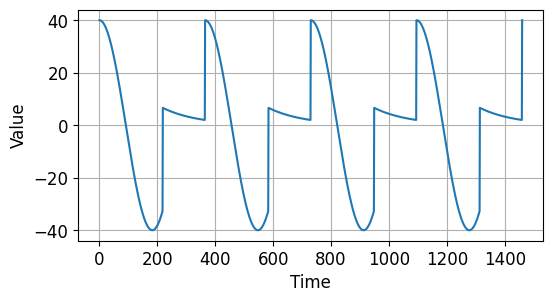
시계열 데이터 기초 - 계절성을 갖는 시계열 데이터¶
예제2¶
baseline = 10
slope = 0.05
series = baseline + trend(time, slope) + seasonality(time, period=365, amplitude=amplitude)
plot_series(time, series)
plt.show()
trend(), seasonality() 함수를 사용해서 경향성 (Trend)과 계절성 (Seasonality)을 모두 갖는 시계열 데이터를 만들었습니다.
아래와 같은 시계열 데이터가 만들어졌습니다.

시계열 데이터 기초 - 경향성/계절성을 갖는 시계열 데이터¶
노이즈를 갖는 시계열 데이터¶
예제1¶
def white_noise(time, noise_level=1, seed=None):
rnd = np.random.RandomState(seed)
return rnd.rand(len(time)) * noise_level
noise_level = 5
noise = white_noise(time, noise_level, seed=42)
plot_series(time, noise)
plt.show()
white_noise() 함수는 0에서 noise_level 값 사이의 임의의 실수를 갖는 시계열 데이터를 반환합니다.
아래와 같은 시계열 데이터가 만들어졌습니다.
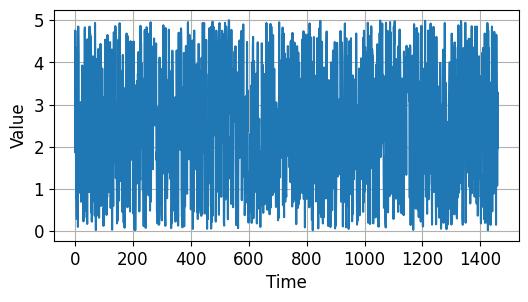
시계열 데이터 기초 - 노이즈를 갖는 시계열 데이터¶
예제2¶
baseline = 10
slope = 0.05
noise_level = 5
series = baseline + trend(time, slope) + seasonality(time, period=365, amplitude=amplitude) \
+ white_noise(time, noise_level, seed=42)
plot_series(time, series)
plt.show()
이번에는 경향성 (Trend), 계절성 (Seasonality)과 노이즈 (Noise)를 모두 갖는 시계열 데이터를 만들었습니다.
아래와 같습니다.

시계열 데이터 기초 - 경향성, 계절성, 노이즈를 갖는 시계열 데이터¶
자기상관성을 갖는 시계열 데이터¶
예제1¶
split_time = 1000
time_train, x_train = time[:split_time], series[:split_time]
time_valid, x_valid = time[split_time:], series[split_time:]
def autocorrelation(time, amplitude, seed=None):
rnd = np.random.RandomState(seed)
pi = 0.8
ar = rnd.randn(len(time) + 1)
for step in range(1, len(time) + 1):
ar[step] += pi * ar[step - 1] ## 이전의 값의 0.8배를 더하기
return ar[1:] * amplitude
series = autocorrelation(time, 10, seed=42)
plot_series(time[:200], series[:200])
plt.show()
autocorrelation() 함수는 자기상관성 (Autocorrelation)을 갖는 시계열 데이터를 반환합니다.
ar은 정규분포를 갖는 임의의 데이터입니다.
이전 시간 스텝 값의 0.8배를 더해주고, 크기 amplitude를 곱한 시계열 데이터를 반환합니다.

시계열 데이터 기초 - 자기상관성을 갖는 시계열 데이터¶
예제2¶
series = autocorrelation(time, 10, seed=42) + trend(time, 2)
plot_series(time[:200], series[:200])
plt.show()
자기상관성 (Autocorrelation)과 경향성 (Trend)을 갖는 시계열 데이터를 만들었습니다.
결과는 아래와 같습니다.
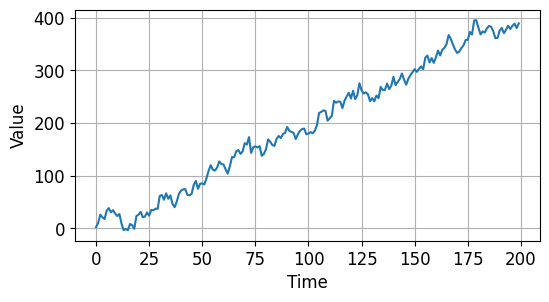
시계열 데이터 기초 - 자기상관성과 경향성을 갖는 시계열 데이터¶
예제3¶
series = autocorrelation(time, 10, seed=42) + seasonality(time, period=50, amplitude=150) + trend(time, 2)
plot_series(time[:200], series[:200])
plt.show()
이번에는 자기상관성 (Autocorrelation), 경향성 (Trend)과 함께 계절성 (Seasonality)을 갖는 시계열 데이터를 만들었습니다.
아래와 같습니다.
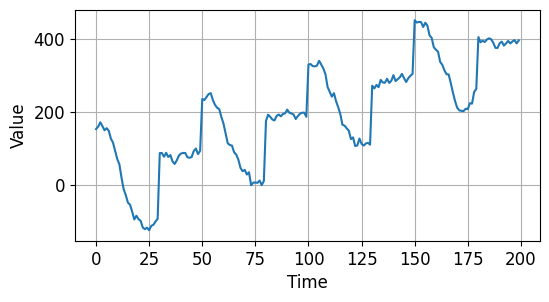
시계열 데이터 기초 - 자기상관성, 경향성, 계절성을 갖는 시계열 데이터¶
예제4¶
series = autocorrelation(time, 10, seed=42) + seasonality(time, period=50, amplitude=150) + trend(time, 2)
series2 = autocorrelation(time, 5, seed=42) + seasonality(time, period=50, amplitude=2) + trend(time, -1) + 550
series[200:] = series2[200:] # 자기상관 amp 10->5, 계절성 amp 150->2, 경향성 slope 2->-1 + 550
series += white_noise(time, 30)
plot_series(time[:300], series[:300])
plt.show()
이번에는 특정 시점 이후로 다른 특성을 갖는 시계열 데이터를 만들어보겠습니다.
2/3 지점 이후로 크기 (amplitude)와 주기 (period), 경향성 (slope)이 모두 달라진 특성을 갖는 시계열 데이터입니다.
또한 전체 구간에서 노이즈 (Noise)를 갖습니다.
결과는 아래와 같습니다.
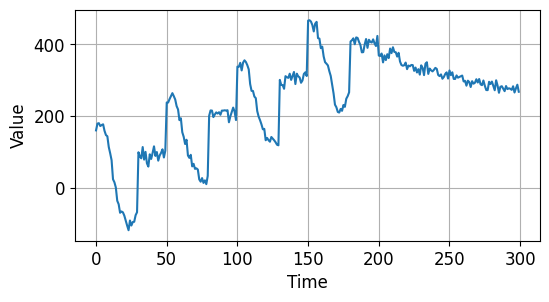
시계열 데이터 기초 - 특정 시점 이후 변화 추세를 갖는 시계열 데이터¶
